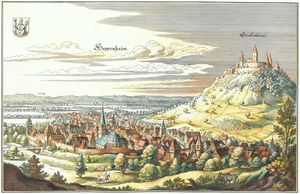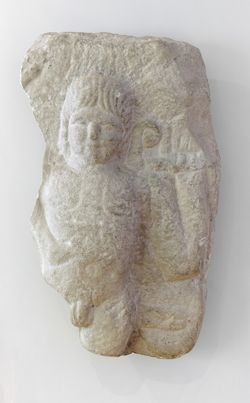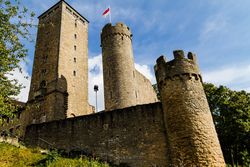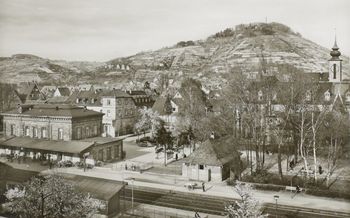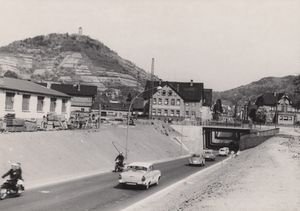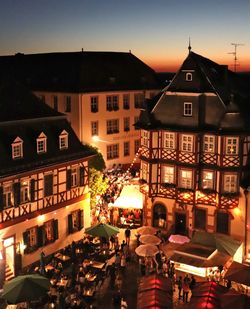With a population of around 28,000, Heppenheim is the fourth largest town in the Bergstraße district.
The district reform at the beginning of the 1970s, when the communities of Erbach, Hambach, Igelsbach, Kirschhausen, Ober-Laudenbach, Mittershausen-Scheuerberg, Sonderbach and Wald-Erlenbach became districts of city Heppenheim, led to formation of Heppenheim as it is today: approx. 52 km² in its current size.
Hesse's southernmost district town, which hosted the Hessentag in 2004 and celebrated the 1250th anniversary of its first mention in the Lorscher Codex in 2005, can look back on a long and eventful history.

Stadtgeschichte
The beginnings of Heppenheim
The beginnings of Heppenheim
Archaeological finds show that the Heppenheim area has been inhabited by people since the Neolithic Age. The oldest datable finds in southern Hesse are stone tools from the district boundary area between Bensheim and Heppenheim.
After the fall of the Roman Empire, the Roman provinces on the right bank of the Rhine were left deserted. By the middle of the 5th century, the Franks had advanced into the Rhine-Main area for the first time and by the end of the 7th century they had sustainably gained power and significantly shaped the civilisation of the Bergstraße.
The Romans and Franks
The area of Bergstraße came under Roman rule in the 1st Century AD. During this time, numerous manors were built, such as the villa rustica in Hemsberg, as well as a well-developed road network (e.g. the north-south connection, known today as Bergstraße).After the fall of the Roman Empire, the Roman provinces on the right bank of the Rhine were left deserted. By the middle of the 5th century, the Franks had advanced into the Rhine-Main area for the first time and by the end of the 7th century they had sustainably gained power and significantly shaped the civilisation of the Bergstraße.
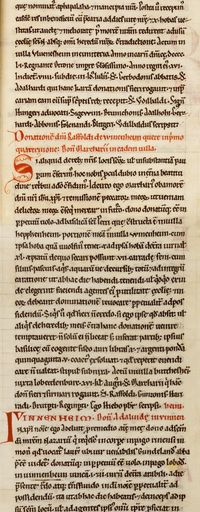
The first mention of Heppenheim in the Lorscher Codex, source: Würzburg State Archives, Mainz books of various contents 72
The First Documented Reference
The town and its St. Peter church were first mentioned in a deed of donation from a Marcharius from Weinheim on July 17, 755 AD. This deed has been passed down through the Lorscher Codex. The Lorscher Codex, one of the most important sources for Central European historiography and topography, documents the properties of the renowned Lorsch Imperial Abbey towards the end of the 12th century.A donation from Charlemagne (Charles the Great) in 773 AD made the ‘mark’ Heppenheim one of the numerous possessions of the imperial abbey.
(A mark was a border between realms or a neutral buffer zone under joint control of two states.)
Von der Mark zur Stadt
From a Mark to a town
From the middle of the 11th century onwards, large numbers of urban centres sprang up, often founded by lords and based around castles or market towns. Although there is no documentary evidence of the granting of town rights to Heppenheim, a town seal dated around 1318 proves that Heppenheim must have received town rights before then.
To protect market trade and the town's inhabitants, Heppenheim was surrounded by a wall with three gates.
To protect market trade and the town's inhabitants, Heppenheim was surrounded by a wall with three gates.
The Starkenburg
A dispute over a donation made by King Henry IV from Lorsch Monastery to Archbishop Adalbert of Bremen prompted the abbot of the imperial abbey, Udalrich, to build Starkenburg Castle on Mount Burcheldon in 1065. The castle served to protect the Lorsch possessions and was able to withstand the first siege by Adalbert of Bremen in January 1066. With the decline of the imperial abbey at the beginning of the 13th century, the Archbishop of Mainz, Siegfried III, acquired Starkenburg Castle and received the monastery with its associated possessions, including the Mark of Heppenheim in 1232.The Kurmainzer Amtshof
The Amtshof (State Hall) was built on the edge of the old town as the seat of the electoral administration. Like most of the town's houses, it was almost completely destroyed by the devastating town fire in 1369 and rebuilt by the end of the 14th century. Along with the north tower of St. Peter's Church, it is one of the oldest buildings in Heppenheim's old town. The Gothic angel fresco in the Elector's Hall, which provides a festive setting for numerous cultural events, probably dates from the time of the reconstruction.Today, the building, which houses the East German Culture and Heritage Rooms as well as the Heppenheim Museum with its storage and exhibition rooms, serves as many purposes, such as being a backdrop for the Bergstraße Wine Market.
Change of rule and plundering
From 1461 to 1623, Heppenheim and the entire Starkenburg district came under Palatinate pledge. Starkenburg was captured by Spanish troops in 1621 during the Thirty Years’ War, and by Swedish troops nine years later. Heppenheim's population, decimated by a plague epidemic in 1635, had to endure the plundering of the town by French troops in 1645. The War of the Palatinate Succession also claimed numerous victims in the Bergstraße region. In 1689, the year of the destruction of Heidelberg Castle, Heppenheim was once again plundered by French troops, and four years later it was set on fire when it was plundered again.Times of upheaval
Times of upheaval
With the abolition of the Electorate of Mainz by the Imperial Deputation in 1803, Heppenheim became part of the Landgraviate of Hesse-Darmstadt (from 1806: Grand Duchy of Hesse), and its new southern province was named Starkenburg.
The Heppenheim Assembly
During the beginning of the 19th century, Germany was shaped and characterised by the effects of the Napoleonic Wars, small-scale statehood, and the sobering resolutions of the Congress of Vienna.On October 10th, 1847, at the invitation of David Hansemann, a merchant and politician from Aachen, prominent delegates from five German states met in Heppenheim to discuss joint action to bring about German state unity.
The "Heppenheim Assembly" became a milestone that contributed to the formation of the National Assembly in the Paulskirche in Frankfurt in 1848. The venue was the "Halber Mond" inn, which still exists today, and the venue’s history dates back to the 17th century.
The Age of Industrialisation
Although the process of industrialisation in the 19th century reached Heppenheim relatively late and there was no significant industrial settlement, strong structural and economic development led to the town's growth.Heppenheim received its railway station - built by the Darmstadt architect Georg Moller - in 1845/1846, just in time for the opening of the Main-Neckar railway line from Frankfurt to Heidelberg. This marked the beginning of the railway era for the district town, which was situated on an old and important north-south transport axis.
In 1866 the so-called "Großherzogliche Landesirrenanstalt bei Heppenheim" (mental asylum funded by the Grand Ducal state) was opened and around 1900, electricity and the telephone were introduced. Administrative buildings, schools, churches, the hospital, the synagogue, and the villa quarter on the Maiberg were also built. The clay works went into operation and the sewage system was laid.
The upswing came to a sudden halt with the outbreak of the First World War.
Heppenheim in the Third Reich
Heppenheim in the Third Reich
The local NSDAP group in Heppenheim is said to have been founded as early as 1927, although Heppenheim's share of the votes for the NSDAP in the Reichstag elections was far below that of the district level.
From 1933 onwards, there was no stopping the National Socialists from gradually gaining power in and taking over Heppenheim either.
From 1933 onwards, there was no stopping the National Socialists from gradually gaining power in and taking over Heppenheim either.
Takeover of politics and administration
The takeover of the administration took place without resistance, considering the social democratic councillors had already left the town hall in protest by the end of March 1933 in order to avoid being kicked out, and also because the centre party colleagues had also withdrawn from the town hall by the end of July after the "Law against the formation of new parties" came into force. Mayor Karl Schiffers, elected in 1925, publicly announced that he was turning his back on the Centre Party and joining the NSDAP in May 1933. In 1937, by the end of his term in office, he was replaced by the loyal Dr. Walter Koehler.Takeover of the press and health services
In 1936, the local press service was taken over, with the local “Ordinance and Advertisement Sheet” being replaced by the newspaper “Der Volksgenosse”. The health care system became increasingly radical when NSDAP and SA member Wilhelm Schmeel took over the post of director of psychiatry in Heppenheim in 1933.Anti-Semitism
Anti-Semitism also became more open and more accepted in Heppenheim through the appearance of partially controlled boycotts or via spontaneous outbreaks of violence, which culminated in the Reichspogromnacht in 1938 with the destruction of the new synagogue on Starkenburgweg and the transport of Jewish men to concentration camps.End of the Second World War
When the US troops marched into Heppenheim on March 27, 1945, the Second World War ended for the Heppenheimers. The first American scouting team encountered German assault guns in Ludwigstraße at around 5 a.m., whereupon the Americans attacked two hours later in preparation for the infantry advance. The positions of the bombs, including those in "In der Krone", suggests that fighter planes flew over the city for reconnaissance and that the targets for the artillery were identified in this way. 15 civilians lost their lives in these attacks.Reconstruction and a new beginning
Reconstruction and a new beginning
The situation in Germany after the Second World War was devastating. The lives of the population were marked by poverty, hunger, and loss. All over Europe there was unimaginable refugee misery.
The negotiations of the victorious allied powers at the Potsdam Conference, that were to shape the post-war system and regime, continued to have an impact for decades to come.
Heppenheim, which had been part of the American occupation zone since the Yalta Conference in 1945, now had to deal with reconstruction, refugees, and denazification – all this under the American military government - and yet also dare to make a new start.
In mid-May 1946, the Bergstraße Trial Chamber, one of 14 trial chambers in the Darmstadt administrative district, began its work to denazify the municipalities of the Bergstraße district. In the “Spruchkammer” (civilian court handling denazification) proceedings, the person concerned had to prove that they were not involved in the Nazi system. The Bergstraße District Court was dissolved at the end of September 1948.
The negotiations of the victorious allied powers at the Potsdam Conference, that were to shape the post-war system and regime, continued to have an impact for decades to come.
Heppenheim, which had been part of the American occupation zone since the Yalta Conference in 1945, now had to deal with reconstruction, refugees, and denazification – all this under the American military government - and yet also dare to make a new start.
Bergstraße Division of Criminal Investigation
The enactment of the "Law for Liberation from National Socialism and Militarism" by the American military government in March 1946 meant that all inhabitants of Hessian municipalities were to be examined for National Socialist activities they had performed in the years 1933 to 1945.In mid-May 1946, the Bergstraße Trial Chamber, one of 14 trial chambers in the Darmstadt administrative district, began its work to denazify the municipalities of the Bergstraße district. In the “Spruchkammer” (civilian court handling denazification) proceedings, the person concerned had to prove that they were not involved in the Nazi system. The Bergstraße District Court was dissolved at the end of September 1948.
Refugees and expellees
In the last years of the Second World War, more than 12 million people were driven from their homes in eastern Germany, and more than 2 million of them died. In February 1946, the first 882 of about 24,000 displaced persons - crammed into freight wagons 40 at a time - arrived in the Bergstraße district. A total of about 1,500 reached the small town of Heppenheim; the largest group was made up of Sudeten Germans.The need to create housing and jobs and to provide for the uprooted people presented Heppenheim with great challenges. The fact that integration was nevertheless successful is also due to the commitment of the citizens.
The expellees preserved their customs and traditions by creating a place to meet and remember their lost homeland in the so-called ‘Heimatstuben’.
The Heppenheim East German Culture and Heritage Room with Schönbacher Stube in the Kurmainzer State Hall has been an integral part of the historical and cultural heritage of the town of Heppenheim since it opened on 17 June 1986.
A new beginning
In Heppenheim, the destruction caused by the Second World War had been limited, which is why the focus in the 1950s and 1960s was on new construction rather than reconstruction.The aim was to create new living space to accommodate the many refugees and displaced persons. Thus, in 1955, a general development plan was passed that was supposed to designate building land for the next 20 years; in the end it was only enough for five years.
Due to the increase in car traffic, the subway in Mozartstraße, completed in 1960, and the subway in Lorscher Straße, which was open to traffic two years later, were built.
The expansion of Heppenheim to the west, which had been long considered impossible due to the nature of the soil there, was made possible in the 1950s and 1960s by extensive drainage measures.
The transition into the new millennium
The transition into the new millennium
In the third millennium, Heppenheim has presented itself with an equally attractive and sustainable symbiosis of history and modernity.
This juxtaposition of old and new, which is also the key to success for the further development of the traditional district town, can be seen through the exploration of the numerous noteworthy sights.
Tourism in Heppenheimis shaped by the diverse landscape and the cityscape; in addition to the picturesque old town and the Starkenburg, the viticulture of the largest wine town on the Bergstraße also has a history rich in tradition.
This juxtaposition of old and new, which is also the key to success for the further development of the traditional district town, can be seen through the exploration of the numerous noteworthy sights.
Tourism in Heppenheimis shaped by the diverse landscape and the cityscape; in addition to the picturesque old town and the Starkenburg, the viticulture of the largest wine town on the Bergstraße also has a history rich in tradition.
Heppenheim offers residents and visitors a wide range of cultural events with historical importance, such as the Bergstraße wine market, the "alley sensations" or the Heppenheimer town fair ("Kerwe").
With their voluntary work, the Heppenheim associations have also made an important contribution to the development of social and cultural life for many decades.
Attractive residential developments in the west and north of the city and the industrial area around Tiergartenstraße have enabled the district town to hold its own in the tough ‘desirable location’ competitions. In addition to its continued important function as an administrative centre, the city has also been able to gain a profile as a commercial and business location.
With their voluntary work, the Heppenheim associations have also made an important contribution to the development of social and cultural life for many decades.
Attractive residential developments in the west and north of the city and the industrial area around Tiergartenstraße have enabled the district town to hold its own in the tough ‘desirable location’ competitions. In addition to its continued important function as an administrative centre, the city has also been able to gain a profile as a commercial and business location.
| Zentrale Dienste Stadtarchiv Heppenheim Museum Heppenheim |
| Postanschrift: |
| Großer Markt 1 64646 Heppenheim |
| Kontakt: |
| Frau Katrin Rehbein Archiv |
| Frau Luisa Wipplinger Museum |
| Stadtgeschichte |
| Zentrale Dienste Stadtarchiv Heppenheim Museum Heppenheim |
| Postanschrift: |
| Großer Markt 1 64646 Heppenheim |
| Kontakt: |
| Frau Katrin Rehbein Archiv |
| Frau Luisa Wipplinger Museum |
| Stadtgeschichte |

